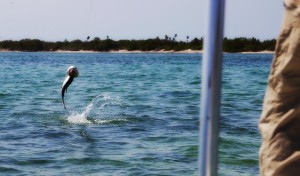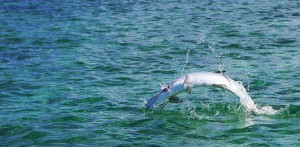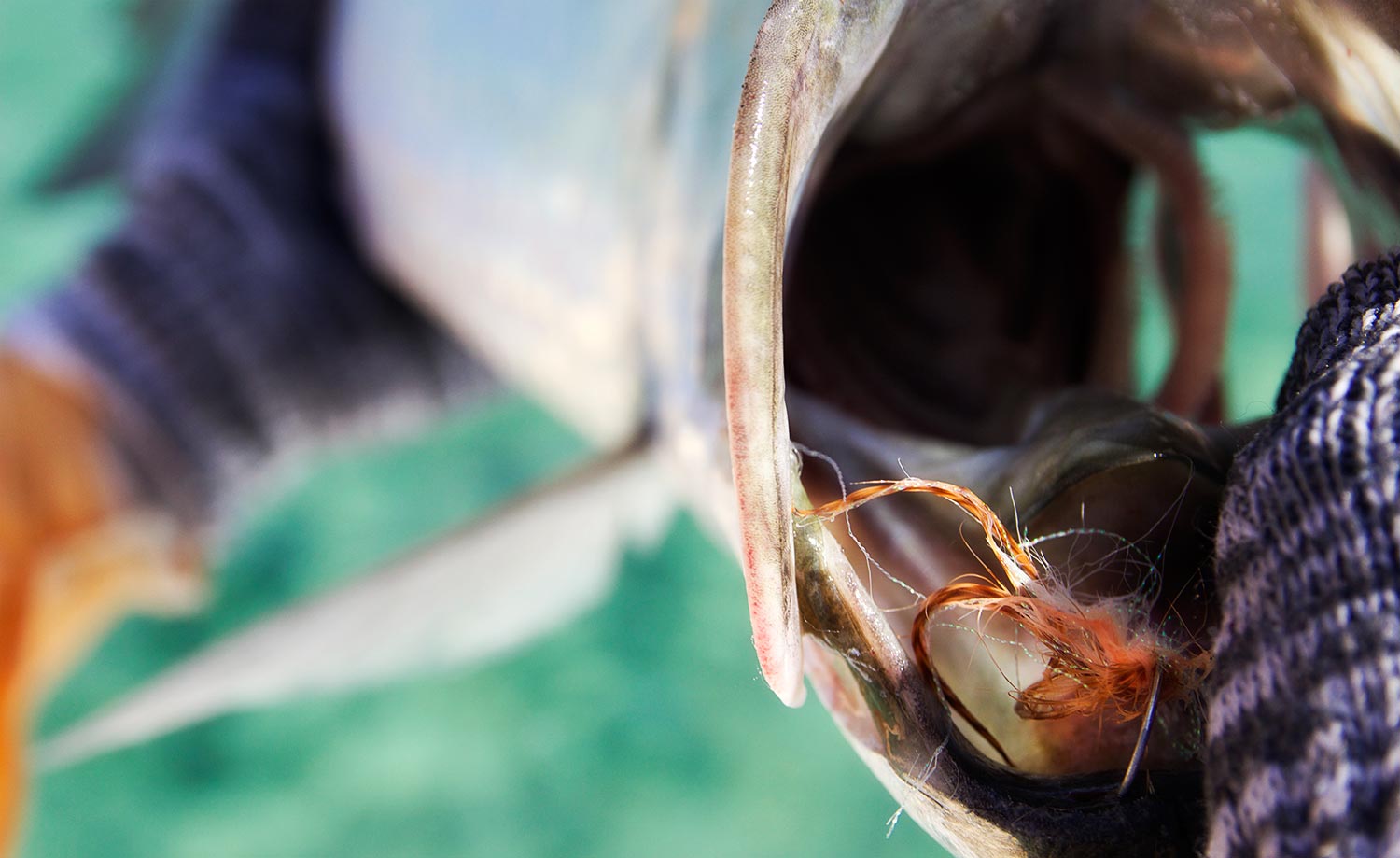By Dan Frasier
I think what surprised me most was that they still looked like fish.
The dark shapes sliding below the surface were intimately familiar despite their legendary status, but the vastness of the flats and channels of Jardines de la Reina off the coast of Cuba seemed to put their size into perspective. The sabalo, Spanish for tarpon, looked natural. Why this surprised me, I don’t know. Perhaps it was the hours of videos I’d watched with monster fish exploding from the water. Or the gallons of ink I’d poured over about the silver king. The grandness of these fish left me anticipating something otherworldly. Where I’d expected to find a tiger in my living room, I’d instead found it in the jungle, where it fits.
From the bow I see the shape quartering toward the boat from 2 o’clock and all of the advice I’d sought in the previous weeks just sloughed away. Eighty feet and moving lazily toward us was simply another cruising fish. One false cast and I shot line to intersect it’s path at 70 feet. A few strips and the fly is in position and very slowly sinking. As the tarpon approached I give it two slow pulls. The calm and lazy shape tenses and snaps its head to the side and all of a sudden I’m holding a live wire and thinking, “Hit him as hard as you can.”
The entire process was strangely familiar to me. Despite having never chased tarpon before, the situations were much like I’d experienced in other saltwater situations and in my carp fishing. See the fish (something that takes training), cast quickly because you may only get one shot, intersect the fish, and don’t make it work too hard or do anything unnatural to eat your fly. Simple, but not easy.
Now don’t get me wrong, I’m still nothing more than a Middle School level tarpon fly fisherman. In the long calls I’d had with real tarpon Phd’s, I’d been given all kinds of tips, information, and strategies on how to address these fish in all of the more difficult situations. This was the kind of information that allows the experts to hook them when you can’t, or hook a higher percentage of his shots than anyone else on the water. Great stuff and extremely helpful when you are trying to take you tarpon game to the next level. But as a rank amateur, I was trying to take my tarpon fishing to ANY level and remembering and implementing these PhD level techniques in the heat of the moment was more than my tiny brain and lack of muscle memory could handle. And yet, I still managed to catch a number of fish, by leaning on what was familiar to me.
Here are a few things I learned while tarpon fishing in Cuba.
1. They are still fish and it’s still flats fishing.
 I had built the idea of chasing tarpon up so much in my head that it felt like I was attempting to do the impossible. Go catch one of the baddest ass fish in the world on a fly rod with no prior experience and in a limited number of days. I’d put so much pressure on myself to convert on this opportunity that I’d nearly psyched myself out. I called everyone I knew with insight into tarpon fishing, talked to people about fishing Cuba (like it was fishing on Mars or in zero gravity), and read and studied like a madman.
I had built the idea of chasing tarpon up so much in my head that it felt like I was attempting to do the impossible. Go catch one of the baddest ass fish in the world on a fly rod with no prior experience and in a limited number of days. I’d put so much pressure on myself to convert on this opportunity that I’d nearly psyched myself out. I called everyone I knew with insight into tarpon fishing, talked to people about fishing Cuba (like it was fishing on Mars or in zero gravity), and read and studied like a madman.
All of this preparation was good. It helped in a lot of ways, but it also displayed just how unprepared I felt and how much pressure I was putting on the trip. Gotta get my Tarpon. May not get another chance like this in years. Make it count, by knowing everything. Pressure is the enemy of good flats fishing. The surest way to blow a cast, miss a strip set or not see fish is to get frantic or stressed by deciding there is a bunch of pressure on this one opportunity. The best flats fishermen are relaxed and confident. Their casts are smooth and patient and they hook and land fish like they’ve been there before. Now don’t get me wrong, they hurry to get the fly where it needs to be, but they hurry like Usain Bolt… long and smooth, not like a startled three-year-old… frantic and jerky.
So take your foot off the gas a little. Slow down and realize it’s still just fishing. Sure your blood will be pumping and your heart thumping, but you’re still just trying to intersect a fish with a fly that looks and acts like food. This is how carp and redfish really helped me. Once I realized I was in a recognizable situation—cruising fish that weren’t going to give me a ton of shots—I was able to slow down and lean on my experience delivering flies in that situation. Absolutely, there were things that a tarpon expert would have done differently, and without a doubt they would have hooked more fish than me. But me trying to act like them may have left me with no fish. Instead I had to go back to what I knew, get my feet under me and my confidence up (and the pressure off) and then I could start to learn tactics to add to my repertoire.
2. Color Matters
Tarpon flies baffled me, prior to my trip. I couldn’t understand why they were so small and the color selection seemed like an ode to the Grateful Dead more than natural colors used to look like baitfish. And hell… I wasn’t even certain it was baitfish we were emulating.
On the second day on the flats we encountered a stream of fish following a shoreline around a point and they were refusing my flies over and over. The guide said I needed to change to an orange fly. He explained that on this particular point the tarpon were cruising close to eat the huge amount of a specific orange baitfish and that they wouldn’t eat a fly that didn’t look like one. I quickly changed to a small orange fly and was tight in the next few casts.
At that point I realized that the colors may be brighter or more varied than I’m used to, but that’s because the baitfish the tarpon encounter also tend to be more wildly colorful. You’d think I would have understood that by simply watching Finding Nemo and noting the hugely varied colors of saltwater fish, but it hadn’t much occurred to me. I thought the color scheme of the flies used for tarpon were more like the color scheme used in pike fishing. Perhaps vaguely suggestive of a living organism but more alchemy than biology. I was wrong. Tarpon experience brightly colored, or unusually colored, baitfish all the time. And when they are encountering your fly you are better off if it looks like something they are eating than if it doesn’t. So I spent more time asking what color the baitfish here were and what color the tarpon wanted, and I change my fly accordingly. I’m certain it helped me hook more fish.
3. Bowing to the king is easier than it seems
Bowing in tarpon fishing is one of the things that makes it seem almost mythological. Here is this fish that is so powerful it requires us to adopt a fighting technique almost specially designed for this species. Granted, people fishing for big fish of all kinds are bowing to jumping fish and Atlantic Salmon fishers have long espoused the bow, but in no other fishing is this requirement so fundamentally associated with the fish.
 I was worried about remembering to bow or being able to bow fast enough when one of these silver kings achieves liftoff. In my experience a fish jumping is almost a surprise and usually happens so quickly it’s up and then done before you can yell, “Holy crap.” That was not my experience with tarpon. The jump was usually preceded by a gather of speed by the fish and an obvious change in the angle of the line in the water. You could FEEL that they were about to throw themselves recklessly into the air and be prepared to give them a bow. It also meant you could get some pretty cool pictures of jumping fish, if you were paying attention while your buddy fought his fish.
I was worried about remembering to bow or being able to bow fast enough when one of these silver kings achieves liftoff. In my experience a fish jumping is almost a surprise and usually happens so quickly it’s up and then done before you can yell, “Holy crap.” That was not my experience with tarpon. The jump was usually preceded by a gather of speed by the fish and an obvious change in the angle of the line in the water. You could FEEL that they were about to throw themselves recklessly into the air and be prepared to give them a bow. It also meant you could get some pretty cool pictures of jumping fish, if you were paying attention while your buddy fought his fish.
I landed far more tarpon than I deserved in Cuba. To stick and jump even a couple of these magnificent fish on a single trip is an honor and I was lucky enough to land more than a couple. The only way that was able to happen was for me to not try and tarpon fish, and instead just fish for tarpon. By leaning on the fundamentals I’d honed from years of sight fishing I was not great, but good enough to make it happen. Will I continue to improve as an get more chances to chase tarpon? Probably. Will I still seek the expertise of the really great tarpon fly fishermen I know? Absolutely. But until I realized I had to crawl before I could walk, and the crawling just meant being fundamentally sound—see the fish, intercept the fish, show them food in a natural way and bow when you can—until I realized that it didn’t have to be more complicated than that to hook a tarpon, I was lost in a flurry of advice and uncertainty. Shaking off all of that thinking and just doing what I knew how to do allowed me to be successful. Simple as that.
Dan Frasier Gink & Gasoline www.ginkandgasoline.com hookups@ginkandgasoline.com Sign Up For Our Weekly Newsletter!


I fished Jardine de las Reinas a year ago after a long draught wherein I could not tempt a tarpon regardless of what I tried. One week there with Avalon and I’d hooked more than twenty and landed thirteen. The guiding was great but the location is magical.
Great aticle!
The “specific orange baitfish” you mentioned is called “lorito” (meaning little parrot). This is not exactly orange in color, but seems to be when viewed from outside the water. This fish (when juvenile) has colors ranging from tan, rust and reddish brown, with spots or reflections in yellow chartreuse color.
I have some pictures of that baitfish. If you want them, I can e-mail them to you.
I am a brazilian fly fisherman, but I have fished in Cuba eight times in the last 5 years and my preferred color combinations for the cuban tarpon flies are (in order of preference): black and purple, black and red, tan and brown or rust, yellow and orange, and green and yellow chartreuse
Great article. You captured the experience perfectly; for, as a freshwater flyfisher, the first trips to the salt for tarpon and bonefish are certainly nerve wrecking, especially with guides and others filling your head with well-meaning instructions and tips (which often contradict one another). One thing I learned with big tarpon is to not rush the hook set, just let the big fish hook himself — then it’s OK to start driving the hook in. Do it too soon and I, for one, always pull the hook out of his mouth. As you suggest, relaxing, trusting your instincts, and having a great guide who doesn’t put too much pressure on you is a formula for success! Again, great article!
Wow what great insight and very timely. I am headed to Cuba in April and this is great advice. I have hooked one tarpon in Key West, about 80 pounds, actually had him to the boat three times. On what I figured to be his last big run a 400 pound bull shark ate him. Bummer Hope for lots of hookups in Cuba. Thanks for the insight.